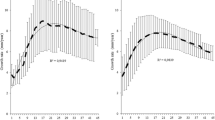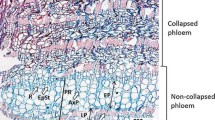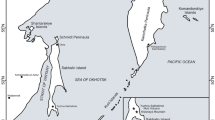Abstract
Douglas-fir (Pseudotsuga menziesii) is a valuable conifer timber species. It has a thick bark with a high proportion of cork in the rhytidome that allows considering its recovery. This study focuses on the characterization of the bark features and their variation with cambial age along the stem using samples of 20 trees from two sites in Portugal at harvest for the sawmilling industry. The morphology and anatomical features of bark were examined including a detailed analysis of the arrangement of tissues, cell biometry, tissue proportion of the phloem, and the development of the rhytidome. Bark structure varied within the tree with cambial age at various height levels, and differences concerned mostly the rhytidome and periderm development, tissue morphology and disarray in the non-conducting phloem. A relationship between cell dimension, proportion of tissues in the phloem and age was observed; the effect of stem height position was statistically significant for sieve cell length, fiber–sclereid length and wall thickness with a decrease from the base to the top. The rhytidome thickness increased with cambial age: At the stem base (45–50 years of cambial age), the bark includes a rhytidome of about 3 cm thickness corresponding to 84% of the bark, with 5–8 periderms, containing nearly 50% of cork. The cork cells were thin-walled and oriented in radial rows, and the occurrence of thick-walled lignified cells was associated with the increments of the phellem layer. In the youngest periderm, the occurrence of phellem cells with empty lumens and thin suberized walls started at 25–30 years of cambial age. The results show that trees with 45–50 years of age and their logs up to 5 m of height may be suitable for bark and cork exploitation.









Similar content being viewed by others
References
Angyalossy V, Pace MR, Evert RF, Marcati CR, Oskolski AA, Terrazas T, Kotina E, Lens F, Mazzoni-Viveiros SC, Angeles G et al (2016) IAWA list of microscopic bark features. IAWA J 37:517–615
Baptista I, Miranda I, Quilhó T, Gominho J, Pereira H (2013) Characterisation and fractioning of Tectona grandis bark in view of its valorisation as a biorefinery raw-material. Ind Crops Prod 50:166–175
Barbosa ACF, Marcelo RP, Witovisk L, Angyalossy V (2010) A new method to obtain good anatomical slides of heterogeneous plant parts. IAWA J 31:373–383
Cardoso S, Pereira H (2017) Characterization of Douglas-fir grown in Portugal: heartwood, sapwood, bark, ring width and taper. Eur J For Res 136:597–607
Cardoso S, Ferreira J, Quilhó T, Pereira H (2017) Cork of Douglas-fir bark: impact of structural and anatomical features on usage. Ind Crops Prod 99:135–141
Chang YP (1954) Bark structure of North American conifer. United States Department of Agriculture, Washington DC
Da Ronch F, Caudullo G, de Rigo D (2016) Pseudotsuga menziesii in Europe: distribution, habitat, usage and threats. In: San-Miguel-Ayanz J, de Rigo D, Caudullo G, Houston Durrant T, Mauri A (eds) European atlas of forest tree species. Publications Office of the European Union, Luxembourg, pp 146–147
den Outer RW (1967) Histological investigation of secondary phloem of gymnosperms. H. Veenman & Zonen NV, Wageningen
Dougal EF (1981) Ultrastructure of parenchyma and sclereids in Douglas-fir [Pseudotsuga menziesii (Mirb.) Franco] bark. Dissertation, Oregon State University
Einspahr DW, Harder ML, Parham RA (1978) Bark and wood properties of pulpwood species as related to separation and segregation of chip/bark mixtures. Project 3212, report ten : a progress report to members of the Institute of Paper Chemistry. Institute of Paper Chemistry, pp 1–113
Evert RF (2006) Esau’s plant anatomy: meristems, cells, and tissues of the plant body: their structure, function, and development. Wiley, New York
Ferreira JPA, Miranda I, Gominho J, Pereira H (2015) Selective fractioning of Pseudotsuga menziesii bark and chemical characterization in view of an integrated valorization. Ind Crops Prod 74:998–1007
Ferreira J, Miranda I, Gominho J, Pereira H (2016) Chemical characterization of cork and phloem from Douglas fir outer bark. Holzforschung 70:475–483
Ferreira JPA, Quilhó T, Pereira H (2017) Characterization of Betula pendula outer bark regarding cork and phloem components at chemical and structural levels in view of biorefinery integration. J Wood Chem Technol 37:10–25
Fromm J (2013) Xylem development in trees: from cambial divisions to mature wood cells. In: Fromm J (ed) Cellular aspects of wood formation. Springer, Berlin, pp 3–39
Gartner BL (1996) Does photosynthetic bark have a role in the production of core vs. outer wood? Wood Fiber Sci 28:53–61
Ghouse AKM, Iqbal M (1977) Trends of size variation in phloem fibres and sieve-tube cells within the bark of some arid-zone trees. Flora 166:517–521
Gricar J, Jagodic S, Prislan P (2015) Structure and subsequent seasonal changes in the bark of sessile oak (Quercus petraea). Trees 29:747–757
Grillos SJ (1956) Structure and development of the bark of Douglas-fir, Pseudotsuga menziesii (Mirb.) Franco. Dissertation, Oregon State College
Grillos SJ, Smith FH (1959) The secondary phloem of Douglas-fir. For Sci 5:377–388
Hall JA (1971) Utilization of Douglas-fir bark. Pacific Northwest Forest and Range Experiment Station, Portland
Hergert HL, Kurth EF (1952) The chemical nature of the cork from Douglas-fir bark. TAPPI 35:59–66
Iqbal M, Ghouse AKM (1983) An analytical study on cell size variation in some arid zone trees of India: Acacia Nilotica and Prosopis Spicigera. IAWA J 4:46–52
Junikka L (1994) Survey of English macroscopic bark terminology. IAWA J 15:3–45
Krahmer R, Wellons J (1973) Some anatomical and chemical characteristics of Douglas-fir cork. Wood Sci 6:97–105
Kurth EF (1953) Chemicals from Douglas-fir bark. Oregon Forest Products Laboratory, Corvallis
Kurth EF, Kiefer HJ (1950) Wax from Douglas-fir bark. TAPPI 33:183–186
Larson PR (1994) The vascular cambium, development and structure. Springer, New York
Le Normand M, Moriana R, Ek M (2014) Isolation and characterization of cellulose nanocrystals from spruce bark in a biorefinery perspective. Carbohydr Polym 111:979–987
Leite C, Pereira H (2017) Cork-containing barks—a review. Front Mater 3:63
Litvay JD (1976) Anatomical and chemical characteristics of the Douglas-fir (Pseudotsuga menziesii (mirb.) Franko) phellem cell. Dissertation, Oregon State University
Litvay JD, Krahmer RL (1977) Wall layering in Douglas-fir cork cells. Wood Sci 9:167–173
Miranda I, Gominho J, Mirra I, Pereira H (2012) Chemical characterization of barks from Picea abies and Pinus sylvestris after fractioning into different particle sizes. Ind Crops Prod 36:395–400
Miranda I, Gominho J, Mirra I, Pereira H (2013a) Fractioning and chemical characterization of barks of Betula pendula and Eucalyptus globulus. Ind Crops Prod 41:299–305
Miranda I, Gominho J, Pereira H (2013b) Cellular structure and chemical composition of cork from the Chinese cork oak (Quercus variabilis). J Wood Sci 59:1–9
Morris H, Jansen S (2016) Bark. Yearbook 2016. International Dendrology Society, Mexico, pp 51–61
Mota GS, Sartori CJ, Ferreira J, Miranda I, Quilhó T, Mori FA, Pereira H (2016) Cellular structure and chemical composition of cork from Plathymenia reticulata occurring in the Brazilian Cerrado. Ind Crops Prod 90:65–75
Nunes E, Quilhó T, Pereira H (1999) Anatomy and chemical composition of Pinus pinea L. bark. Ann Sci 56:479–484
Parameswaran N (1980) Some remarks on the nomenclature of fibres, sclereids and fibre–sclereids in the secondary phloem of trees. IAWA J 1:130–132
Patel RN (1975) Bark anatomy of radiata pine, corsican pine, and Douglas fir grown in New Zealand. N Z J Bot 13:149–167
Pereira H (2007) Cork: biology, production and uses. Elsevier Publications, Amsterdam
Pereira H (2015) The rationale behind cork properties: a review of structure and chemistry. BioResources 10:6095–6206
Pereira H, Knapic S (2017) Bark and cork. In: Performance of bio-based building materials. Elsevier Publications, Amsterdam, pp 78–96
Pereira H, Miranda I, Tavares F, Gominho J, Quilhó T, Graça J, Rodrigues JC, Shatalov A, Knapic S (2010) Qualidade e utilização tecnológica do eucalipto (Eucalyptus globulus) [Quality and technological use of eucalyptus (Eucalyptus globulus)]. Centro de Estudos Florestais, Lisboa, p 377 (in Portuguese)
Pinto PCRO, Sousa AF, Silvestre AJD, Neto CP, Gandini A, Eckerman C, Holmbom B (2009) Quercus suber and Betula pendula outer barks as renewable sources of oleochemicals: a comparative study. Ind Crops Prod 29:126–132
Quilhó T, Pereira H, Richter HG (1999) Variability of bark structure in plantation-grown Eucalyptus globulus. IAWA J 20:171–180
Quilhó T, Pereira H, Richter HG (2000) Within-tree variation in phloem cell dimensions and proportions in Eucalyptus globulus. IAWA J 21:31–40
Quilhó T, Sousa V, Tavares F, Pereira H (2013) Bark anatomy and cell size variation in Quercus faginea. Turk J Bot 37:561–570
Ridoutt BG, Sands R (1993) Within-tree variation in cambial anatomy and xylem cell differentiation in Eucalyptus globulus. Trees 8:18–22
Ross WD, Corden ME (1973) Microscopic and histochemical changes in Douglas fir bark: accompanying fungal invasion. Wood Fiber Sci 5:129–138
Ross WD, Corden ME (1974) Selective degradation of lignin and condensed tannins of Douglas-fir bark sclereids by fungi. Wood Fiber Sci 6:1–12
Ross WD, Krahmer RL (1971) Some sources of variation in structural characteristics of Douglas-fir bark. Wood Fiber Sci 3:35–46
Şen A, Miranda I, Santos S, Graça J, Pereira H (2010) The chemical composition of cork and phloem in the rhytidome of Quercus cerris bark. Ind Crops Prod 31:417–422
Şen A, Quilhó T, Pereira H (2011) Bark anatomy of Quercus cerris L. var. cerris from Turkey. Turk J Bot 35:45–55
Trockenbrodt M (1994) Quantitative changes of some anatomical characters during bark development in Quercus robur, Ulmus glabra, Populus tremula and Betula pendula. IAWA J 15:387–398
Acknowledgements
We thank Instituto da Conservação da Natureza e das Florestas (ICNF) for helping in tree selection and the sawmills Albano Leite da Silva, LDA and VilaMadeiras - Comércio de Madeiras, LDA, for allowing the sampling at the time of tree harvest. Centro de Estudos Florestais (CEF) is a research unit funded by Fundação para a Ciência e a Tecnologia (FCT) (AGR/UID00239/2013). The first author acknowledges a FCT doctoral fellowship (PD/BD/52404/2013) under the Sustainable Forests and Products (SUSFOR) doctoral program.
Author information
Authors and Affiliations
Corresponding author
Additional information
Publisher's Note
Springer Nature remains neutral with regard to jurisdictional claims in published maps and institutional affiliations.
Rights and permissions
About this article
Cite this article
Cardoso, S., Quilhó, T. & Pereira, H. Influence of cambial age on the bark structure of Douglas-fir. Wood Sci Technol 53, 191–210 (2019). https://doi.org/10.1007/s00226-018-1055-5
Received:
Published:
Issue Date:
DOI: https://doi.org/10.1007/s00226-018-1055-5




